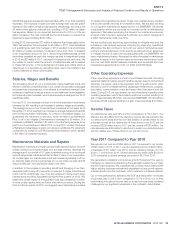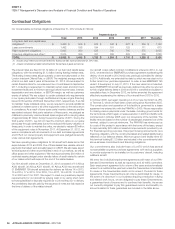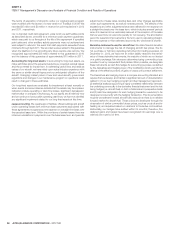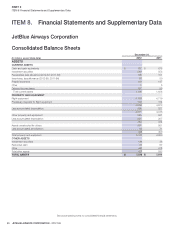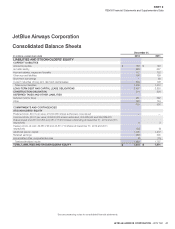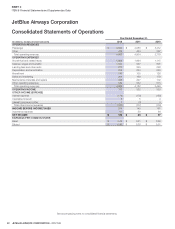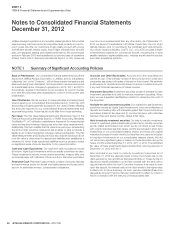JetBlue Airlines 2012 Annual Report Download - page 41
Download and view the complete annual report
Please find page 41 of the 2012 JetBlue Airlines annual report below. You can navigate through the pages in the report by either clicking on the pages listed below, or by using the keyword search tool below to find specific information within the annual report.
JETBLUE AIRWAYS CORPORATION-2012 10K 37
PART II
ITEM7Management’s Discussion and Analysis of Financial Condition and Results of Operations
Off-Balance Sheet Arrangements
None of our operating lease obligations are refl ected on our balance sheet.
Although some of our aircraft lease arrangements are with variable interest
entities, as defi ned by the Consolidations topic of the Financial Accounting
Standards Board’s, or FASB, Accounting Standards Codifi cation™, or
Codifi cation, none of them require consolidation in our fi nancial statements.
The decision to fi nance these aircraft through operating leases rather
than through debt was based on an analysis of the cash fl ows and tax
consequences of each fi nancing alternative and a consideration of liquidity
implications. We are responsible for all maintenance, insurance and other
costs associated with operating these aircraft; however, we have not made
any residual value or other guarantees to our lessors.
We have determined that we hold a variable interest in, but are not the
primary benefi ciary of, certain pass-through trusts which are the purchasers
of equipment notes issued by us to fi nance the acquisition of new aircraft
and certain aircraft spare parts owned by JetBlue and held by such
pass-through trusts. These pass-through trusts maintain liquidity facilities
whereby a third party agrees to make payments suffi cient to pay up to
18months of interest on the applicable certifi cates if a payment default
occurs. The liquidity providers for the Series2004-1 aircraft certifi cates and
the spare parts certifi cates are Landesbank Hessen-Thüringen Girozentrale
and Morgan Stanley Capital ServicesInc. The liquidity providers for the
Series2004-2 aircraft certifi cates are Landesbank Baden-Württemberg
and Citibank, N.A.
We use a policy provider to provide credit support on our ClassG-1 and
ClassG-2 fl oating rate enhanced equipment notes. The policy provider
has unconditionally guaranteed the payment of interest on the certifi cates
when due and the payment of principal on the certifi cates no later than
18months after the fi nal expected regular distribution date. The policy
provider is MBIA Insurance Corporation (a subsidiary of MBIA,Inc.). Financial
information for the parent company of the policy provider is available at
the SEC’s website at http://www.sec.gov or at the SEC’s public reference
room in Washington, D.C.
We have also made certain guarantees and indemnities to other unrelated
parties that are not refl ected on our balance sheet which we believe will not
have a signifi cant impact on our results of operations, fi nancial condition
or cash fl ows. We have no other off-balance sheet arrangements. See
Notes 2, 3 and 12 to our consolidated fi nancial statements for a more
detailed discussion of our variable interests and other contingencies,
including guarantees and indemnities.
Critical Accounting Policies and Estimates
The preparation of our fi nancial statements in conformity with generally
accepted accounting principles requires management to adopt accounting
policies and make estimates and judgments to develop amounts reported
in our fi nancial statements and accompanying notes. We maintain a
thorough process to review the application of our accounting policies and to
evaluate the appropriateness of the estimates that are required to prepare
our fi nancial statements. We believe that our estimates and judgments
are reasonable; however, actual results and the timing of recognition of
such amounts could differ from those estimates. In addition, estimates
routinely require adjustment based on changing circumstances and the
receipt of new or better information.
Critical accounting policies and estimates are defi ned as those that are
refl ective of signifi cant judgments and uncertainties, and potentially result
in materially different results under different assumptions and conditions.
The policies and estimates discussed below have been reviewed with
our independent registered public accounting fi rm and with the Audit
Committee of our Board of Directors. For a discussion of these and other
accounting policies, see Note1 to our consolidated fi nancial statements.
Passenger revenue. Passenger ticket sales are initially deferred in air traffi c
liability. The air traffi c liability also includes customer credits issued and
unused tickets whose travel date has passed. Credit for unused tickets
and customer credits can each be applied towards another ticket within 12
months of the original scheduled service or 12 months from the issuance of
the customer credit. Revenue is recognized when transportation is provided
or when a ticket or customer credit expires. We also defer, in air traffi c liability,
an estimate for customer credits issued in conjunction with the JetBlue
Airways Customer Bill of Rights we expect to be ultimately redeemed. These
estimates are based on historical experience and are periodically evaluated,
and adjusted if necessary, based on actual credit usage.
Frequent fl yer accounting. We utilize a number of estimates in accounting
for our TrueBlue customer loyalty program, or TrueBlue. We record a
liability, which was $10 millionand $9 million as of December31, 2012
and 2011, respectively, for the estimated incremental cost of outstanding
points earned from JetBlue purchases that we expect to be redeemed. The
estimated cost includes incremental fuel, insurance, passenger food and
supplies, and reservation costs. We adjust this liability, which is included
in air traffi c liability, based on points earned and redeemed, changes in the
estimated incremental costs associated with providing travel and changes
in the TrueBlue program. In November 2009, we launched an improved
version of TrueBlue, which allows customers to earn points based on the
value paid for a trip rather than the length of the trip. In addition, unlike our
original program, the improved version does not result in the automatic
generation of a travel award once minimum award levels are reached, but
instead the points are maintained in the account until used by the member
or until they expire 12 months after the last account activity. As a result of
these changes, breakage, or the points that ultimately expire unused, has
been substantially reduced. Periodically, we evaluate our assumptions for
appropriateness, including comparison of the cost estimates to actual costs
incurred as well as the expiration and redemption assumptions to actual
experience. Changes in the minimum award levels or in the lives of the
awards would also require us to reevaluate the liability, potentially resulting
in a signifi cant impact in the year of change as well as in future years.
Points in TrueBlue can also be sold to participating companies, including
credit card and car rental companies. These sales are accounted for as
multiple-element arrangements, with one element representing the fair value
of the travel that will ultimately be provided when the points are redeemed
and the other consisting of marketing related activities that we conduct with
the participating company. The fair value of the transportation portion of
these point sales is deferred and recognized as passenger revenue when
transportation is provided. The marketing portion, which is the excess of
the total sales proceeds over the estimated fair value of the transportation
to be provided, is recognized in other revenue when the points are sold.
Deferred revenue for points sold and not redeemed is recognized as revenue
when the underlying points expire. Deferred revenue was $101 million and
$84 million at December31, 2012 and 2011, respectively.




